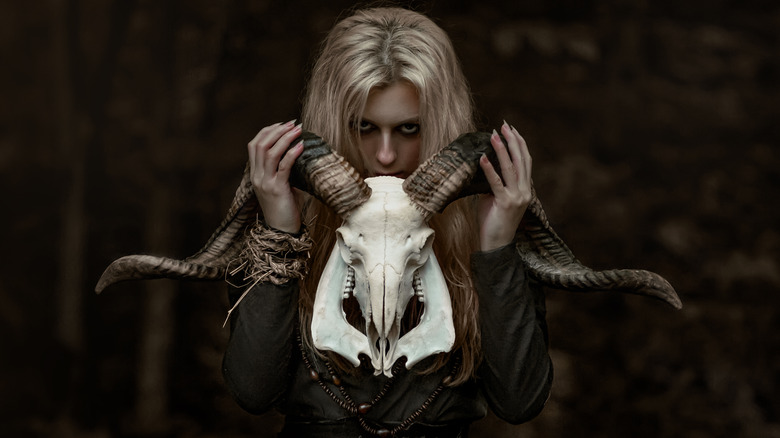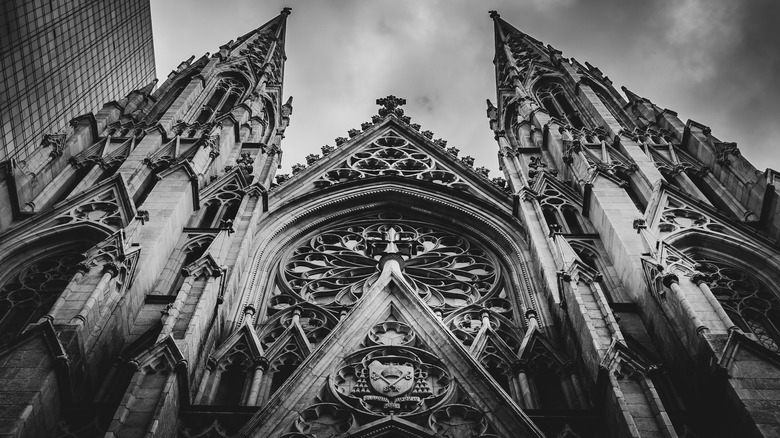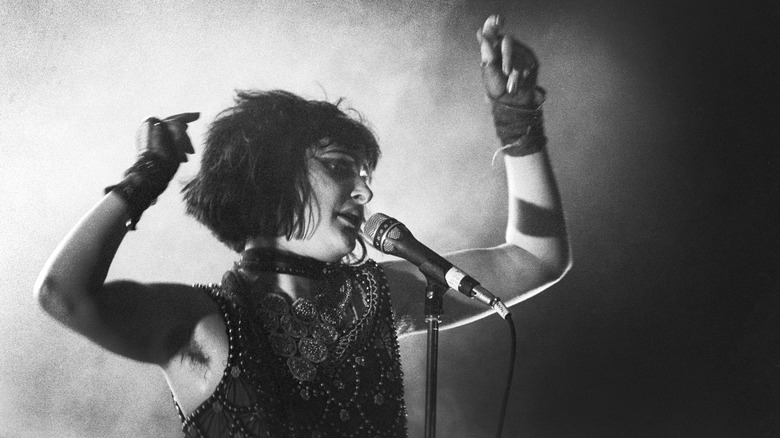Here's How Ancient Goths Are Connected To Modern-Day Goths
The word "goth" or "gothic" conjures up significantly different meanings, depending on the context. How is it possible that "goth" refers to both a person in black makeup listening to Bauhaus and the Germanic tribes that attacked Rome?
Much about the ancient goths is lost to history. We do know the Goths were a Germanic nomadic group who first appeared in written records around A.D. 75 (via History and World History). To the Romans, the Gothic tribes brought about the "Dark Ages," with their centuries of aggression that ultimately resulted in the sacking of Rome in A.D. 410 (per Live Science). This transition from the "enlightened" Roman culture to the Dark Ages signals one of the main threads between the ancient tribes and today's black-wearing alternative culture. For centuries, the word "gothic" has been used fondly and derisively to signal the concept of darkness, explains Josh Jones of Open Culture.
Furthermore, a sense of outsider-ness exists within all things goth and gothic. Historian Herwig Wolfram laments (via World History), "Anyone in the field of Gothic history must expect to be misunderstood, rejected, even stigmatized." He describes people's readiness "to either reject the Goths as an embodiment of everything wicked and evil or to identify with them and their glorious history." The goths and their legacy are more complicated than a simple good/bad explanation. This complexity resonates throughout everything goth and gothic. Let's take a look at the through lines between history's many versions of gothic and today's goths.
Harbingers of darkness: the ancient Goths
No one knows from where the Goths originated. One 6th-century text describes their homeland as "Scandza," a cold island, which many think refers to modern-day Scandinavia, explains Live Science. However, according to World History Encyclopedia's Joshua Mark, historians are skeptical of the text's validity.
We do know that the early gothic tribes worshiped pagan gods. Because of this, some argue that the Goths didn't attack Rome out of sheer aggression. Instead, the Goths feared the threat that Rome and Christianity posed to their way of life, says Rachel K. Fischer in RUSA. The Romans turned down their noses at the Gothic tribes, often using language that called them less-than-human, explains Mark. Later, the word gothic would be a synonym for crude or uncivilized.
The Goths' rise to power transitioned Europe into the Medieval Ages. For the Romans, who saw themselves as highly sophisticated, technological, and rational, this change meant a fall into the darkness. However, Rome also destroyed many advanced societies to become the leading regional power, emphasizes Mark. Interestingly, instead of replacing Roman culture with their own, the Goths upheld many aspects of Roman tradition, eventually combining it with Christianity. Rather than destroying, the Goths preserved, which is why Open Culture's Josh Jones is hesitant to call all things gothic counter-culture. Much of what we know about Roman culture is thanks to the Goths. A thread that ties many gothic movements together is that many often misunderstand them.
Art of darkness: medieval architecture
The next time the word "gothic" appears is nearly 1,000 years later as an insult. The 16th-century Italian artist and writer Giorgio Vasari used the term "gothic" to describe medieval architecture, specifically its grand and intimidating cathedrals (via Britannica). Today, we still use "Gothic" to describe the architectural style of European buildings from the 12th to 16th centuries. However, Vasari used the word "gothic" as a criticism to highlight the superiority of Renaissance art (per Open Culture). In this way, Vasari perpetuated the view that the Goths brought a dark and unenlightened time.
Many — including Vasari — called medieval aesthetics "Gothic" as a synonym for "barbaric" (via Live Science). However, Gothic structures are ornate and meticulously crafted (via RUSA). Gothic churches are tall and impressively technical, and engineering feats focused on harmony, detail, and religious symbolism (via Britannica). The towering structures reflect the Christian belief of the spirit ascending to the light of heaven. Medieval engineers created complex ribbed vaults and flying buttresses to create these tall and heavy structures that teams of sculptors and laborers took years to complete (per Met Museum).
As the now-called Gothic style spread throughout Europe, cathedrals and castles also included intricate window frames and stained glass. Gothic-style sculptures' detail-oriented technique and adherence to life-like representations lay the groundwork for Renaissance sculpture. However, Renaissance artists would later consider Gothic art crude and cultureless (via Britannica).
The haunted castle's secrets: gothic literature
A few centuries later, gothic reappeared in the form of a new literary movement. The British romantic author Horace Walpole described his 1764 book, "The Castle of Otranto," as "gothic." For Walpole, the gloomy abandoned medieval churches, rife with religious symbolism and mysterious ritual, were an alluring break from Enlightenment reason and rationalism (per Open Culture). Walpole was so taken with Gothic architecture that he built a Gothic-style castle named Strawberry Hill House, making him the first modern-day goth, argues Olivia Waring of Metro.
The Gothic novel rose in popularity. Gloomy medieval locations and crumbling ruins characterized the stories. In the haunted locales lurked sinister and frightening characters or an ominous secret (via Britannica and Thought Co.). Gothic plots often blend horror and the supernatural with romance and heroism. Terrifying is mixed with the alluring, reflecting medieval architecture's sublime combination of light and shadow (per RUSA and Thought Co.).
Famous gothic novels include Bram Stoker's "Dracula" and Mary Shelley's "Frankenstein." Edgar Allen Poe famously capitalized on the gothic trend (via Live Science). The gothic novel peaked in the late 18th century, but subsequent generations remade and repurposed the genre (per Britannica). For example, in the U.S., the southern gothic genre exposes and explores the antebellum South's racial injustice, poverty, and crime using supernatural elements like ghosts, zombies, and vampires (via RUSA). In this way, Gothic literature and its offshoots lay the groundwork for today's horror movies, detective fiction, and psychological thrillers (per Thought Co.).
A Subculture of outcasts: modern goths
Gothic literature's moody obsession with life outside the norm endured into the 20th century through horror films like "Nosferatu" and the playfully disturbing artwork of Edward Gorey. Even campy television shows like "The Munsters" kept Gothic themes in circulation (via RUSA). What we know as goth today emerged out of the late 1970s' post-punk music scene and drew from the gothic love of all things dark, secret, and mysterious.
The critic John Stickney first used "goth" to describe music. In 1967, he called The Doors "gothic rock." Around the same time, the American critic Kurt Loder described the Velvet Underground's "All Tomorrow's Parties" as a "mesmerizing gothic-rock masterpiece" (per Metro). Several years later, bands like Siouxie Sioux and the Banshees, Bauhaus, and The Dammed made goth music and fashion — pale skin, dark makeup, and wild hair — a genre of its own. Goths took the dark clothes and piercings from punk but ditched the anger for a romance with the dark and magic (via Encyclopedia.com). Eventually, Joy Division's manager described his band as "gothic," solidifying goth as a distinct sound and aesthetic. By the 1980s, the goth firmly stood as a dark and moody alternative to the decade's pastel and neon pop culture.
Despite their sometimes spooky exteriors, goths are known for their culture of acceptance, embracing alternative lifestyles, and challenging gender norms (per Encyclopedia.com). In 2004, the Edmonton Journal (via The Washington Post) ran the headline "Goth subculture of outcasts surprisingly gentle, polite."
Romancing the mainstream: goths today
Goth culture, a global phenomenon with major hubs in Germany, Japan, and Mexico is finding a home in the mainstream (per The Washington Post). The Guardian reported celebrities such as Meghan Fox, Willow Smith, and Olivia Rodrigo donning goth staples, including the dark velvet, satin, lace, studs, fishnets, and leather described by the Museum of Youth Culture. Instead of the "deathly looking goth," says culture and fashion writer Daniel Rodgers (via The Guardian), the celebrity goth is more a "gesture at subculture more generally." It draws from several looks and inspirations, and the broader culture is following suit. The Gen Z-loved online resale company Depop reported that in October of 2021, searches for "black corset top" went up 200% (via The Guardian).
It may seem surprising that goth culture is appearing in the mainstream since the culture is defined by its difference from the norm. However, The Washington Post's Libby Copeland suggests that the mutability of gothic aesthetic and culture keeps it surviving. Each generation redefines the meaning of "goth." Goth and all things gothic are a shifting and adaptive home for anti-normal sentiments to find refuge. Goth is an ever-changing culture of opposition rooted in a love of darkness. As the DJ Lord Fer of Mexico City's thriving goth scene explained to Scarlett Lindeman in PrimeMind, "This is not a teenage dream for us ... it's a way of life."





